A sideblog strictly for reblogs and the occasional share. For my art/main blog, see KudoTsurugi, link below.
Don't wanna be here? Send us removal request.
Text
Good news, Conan fans! We have more episodes on the way!
And if you're at Anime NYC this month, there will be a world premiere of the Black Iron Submarine movie on the 23rd!
Let's keep up the support, so we can get more episodes in the West!
ATTENTION DETECTIVE CONAN/CASE CLOSED FANS! WE HAVE A NEW DUB AND YOU SHOULD BE WATCHING!
In case you haven't heard, TMS Entertainment released a new English dub of select episodes for Detective Conan on both Netflix and Crunchyroll earlier this month. The collection titled Conan VS The Black Organization, features the following episodes:
Ep 1: The Rollercoaster Murder Case
Ep 2: The Kidnapping of the Company President's Daughter
Ep 128: The Black Organization: 1 Billion Yen Robber Case
Ep 129: The Girl from the Black Organization and the University Professor Murder Case
Ep 176-178: Re-Encounter with the Black Organization
Ep 230-231: Mysterious Passenger
I have more to say under the cut, but here's the TLDR: This collection has new, faithfully dubbed content with new & returning cast members, and TMS plans to commission more of this dub if it does well. Please support it!
If you've decided to keep reading, here are more details.
If you recall the old Funimation dub, it ended around episode 123 of the series (listed as 130 on their DVDs due to splitting the double-length episodes into two-parters) due to low sales, so they never reached a majority of the episodes listed above. So, aside from episodes 1 & 2(titled The Big Shrink and The Kidnapped Deputante in the Funi dub), which were also redubbed, this is the first time these episodes have been officially brought over to the West!
Fans will also be happy to know this new dub by Studio Nano in Texas follows suit with Bang Zoom and Discotek's movie dubs in that all Japanese character and location names are retained, and the dub scripts are more faithful to the Japanese original. In addition, we have a mix of old and new voice talent among the Conan cast, including:
Molly Zhang as Conan Edogawa
Mauricio Ortiz-Segura as Shinichi Kudo
Megan Shipman as Ran Mori
Robert McCollum as Kogoro Mori
Alexis Tipton as Ai Haibara
Christopher Guerrero as Professor/Doctor Hiroshi Agasa
Mark Stoddard as Inspector Megure
Colleen Clinkenbeard as Vermouth
Nick Huber as Gin
David Matranga as Vodka
In addition, TMS has been premiering a movie dub each week on their YouTube channel, which will include the 5th Conan movie, Countdown to Heaven, premiering on the 26th of July at 7pm PT/10pm ET. Presumably, it will have a redub, but we don't know at the time of this post if it will be from Bang Zoom or Studio Nano. If it's available to watch in your country, please go watch them, show your support for more Conan, and most importantly: Be Respectful.
UPDATE(24/07/2025): The movie premiere of Countdown to Heaven has been confirmed by TMS' Youtube link to be an English subtitled release. While this may be disappointing to those hoping for a new dub of the movie, please support the premiere all the same. More Conan available in the West is always a good thing.
For anyone wishing for the old Case Closed dub to return, I say this: as a fan of the old dub and its cast, the Studio Nano dub is probably the closest we've come to capturing the spirit of that dub while still respecting the source material. Stoddard was the original voice of Inspector Meguire(Megure) and is reprising the role. Clinkenbeard was previously the voice of Rachel Moore(Ran) and is now playing the role of Vermouth. Additionally, McCollum, who is our new Sleeping Kogoro, had a role in the old dub as soccer player Harrison Acres (Hideo Akagi).
In terms of the new talent listed, Tipton carries the spirit of Haibara's more jaded and sarcastic personality, performing that scene in episode 129 to perfection. Ortiz-Segura's performance as Shinichi is closer to Kappei Yamaguchi's portrayal in pitch, but is a solid voice for the character, and I hope to hear more from him in future dubbed episodes. Guerrero's performance as Agasa even brings back his European accent, going for a more British take on the voice rather than German, which is somewhat fitting as Agasa is the Watson to Conan's Holmes. And above all, Molly Zhang nails Conan Edogawa, able to vary her delivery to convey a clear difference between Conan's "I'm just a little kid" act and when he's in full deduction mode.
Finally, considering TMS is willing to make more of this dub if it does well, that means we could potentially see more returning cast members from the Case Closed dub in new roles, or even reprising! Imagine Jerry Jewell(Jimmy Kudo in the Funi dub) coming back to reprise as the Phantom Thief Kid, or even taking up the role of Shinichi's father, Yuusaku Kudo, or Kevin M Connolly(Harley Hartwell in the Funi dub) coming back to reprise as Heiji Hattori. I don't know about you, but I would love to see it. At the same time, maybe there could be reprisals from the Bang Zoom cast for the newer characters, like Kyle McCarley's Toru Amuro or Jenny Yokobori's Masumi Sera. Who knows, maybe they'll even dub Magic Kaito with this studio? One can hope🤞
Again, I really hope this dub does well, because right now, anything that can lessen the gap in episodes legally is a good thing. If you live in any English-speaking-majority country in the West(America, Canada, UK, Ireland) and look up the episodes for 'Case Closed(Detective Conan)' on Crunchyroll, you'll notice there is a 631-episode-long gap between episodes 123(where Funimation stopped) and 754(when Crunchyroll picked up the license).
Obviously, asking for dubs of every single missing episode would be too big an ask, but collections of select episodes based on important characters or arcs are significantly more doable.
So please, if you're a fan of this show and these characters, watch and rewatch the new dub on Crunchyroll and Netflix, check out the movie premieres if you can, and respectfully let TMS know that we want more Conan in the English West. Because if they know we want it, they'll keep making it.
As Conan always says, there is always only one truth. Or to put it another way...😏

Only one truth prevails!
17 notes
·
View notes
Text
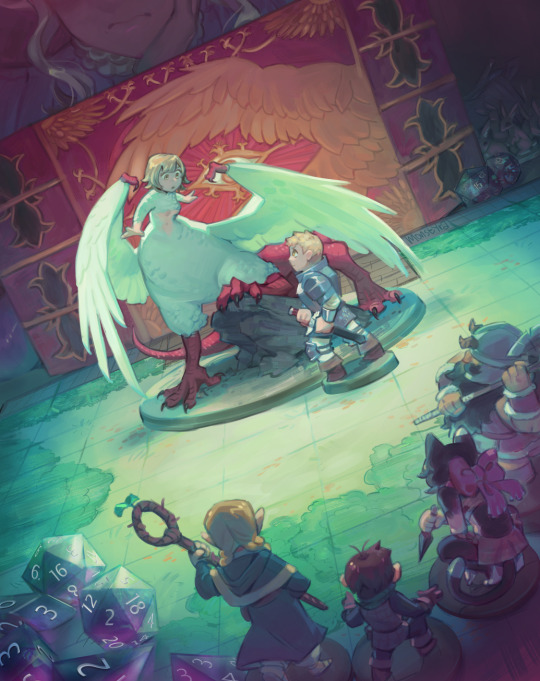
delicious in dungeon :3c
available as a print in my new shop!
22K notes
·
View notes
Text
[Updated Version]
Conan Edogawa by the different Animation Directors who worked on the show during the traditional animation era (001-284).
須藤昌朋 Masatomo Sudo is the Character Designer of the show.
The complete list of Animation Directors
The evolution of some Animation Directors in their drawings






























227 notes
·
View notes
Text
越智浩仁 Hirohito Ochi is also one of those veteran artists who have been involved in the production of Detective Conan since the very beginning, with a style of his own. He has worked on a vast number of episodes, particularly those featuring the Detective Boys, and initially collaborated mainly with the Animation Director 大河原晴男 Haruo Ogawara in the early stages of the series production. Like his peer Masato Sato, he was also appointed as the series director (505 to 666) during an extremely difficult period, primarily working on openings and endings. One of the differences from the others is that he also wrote his own original scripts for the series, the most well-known being : Dracula's Villa Murder Case and A Cursed Mask Coldly Laughs.
Let's take a look at his work during Detective Conan's prime.
One of Ochi's distinctive traits is his use of experimental colored backgrounds in transition scenes, blending them with the tone and style he wants to convey. He incorporates onomatopoeia, manga speech bubbles, pastel pencil backgrounds, cartoonish scenes, and even typography. This use of almost childlike backgrounds not only adds style but also emphasizes the fact that Shinichi has the body of a child.

A diverse framing palette, offering a bit of everything…

With a preference for low-angle shots, often playing with Conan's size in the process.

Unlike Sato or Yamamoto, who make the scenes where Conan finds clues or is in a moment of reflection more dynamic, Ochi prefers static backgrounds with a blue gradient, even later in the anime.
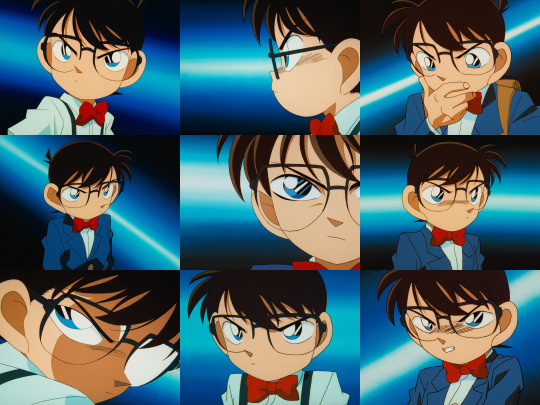
He is also obsessed with the mid/late afternoons depiction, which can range from a simple orange to red.
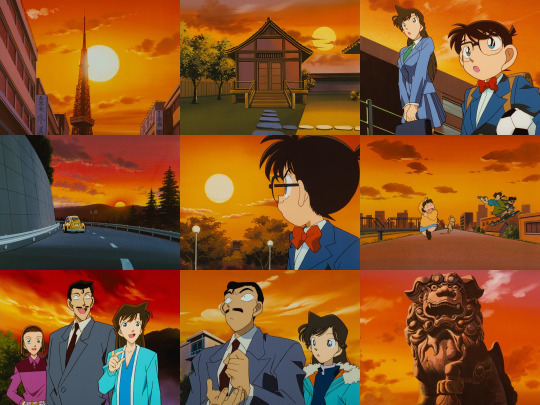
What's interesting about the Ochi episodes is that they make full use of Gosho Aoyama's early artstyle. The scenes are very dynamic and exaggerated, using Masatomo Sudo's flexible designs to the fullest, with Ogawara further enhancing this sensation (where the adaptations of Magic Kaito have failed doing this, for example).
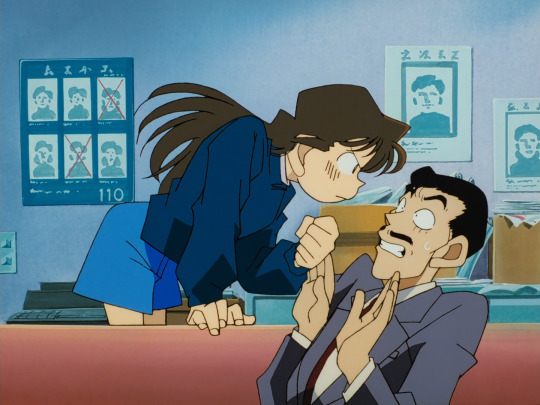


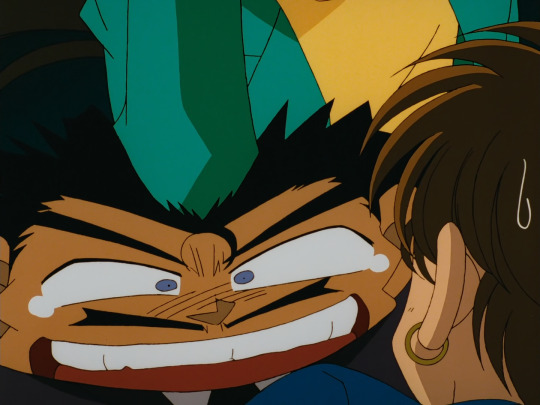
The scene in the top right, was animated by the very famous Character Designer 岸田 隆宏 Takahiro Kishida.

Ochi wrote, storyboarded, and directed episodes 88 and 89 Dracula's Villa Murder Case, which are of great quality. There are inspirations from Dezaki's direction (notably Oniisama E), which is not surprising because he is a reference for everyone, as well as from the Japanese movie Evil Dracula (the atmosphere, the hallways, the manor, the sofa in the center, etc...).
Oniisama E (1991) Dir : Osamu Dezaki


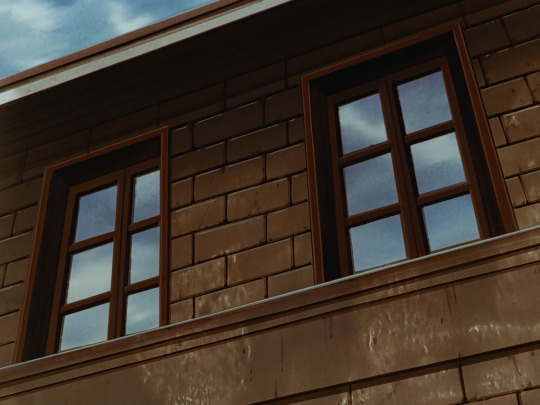

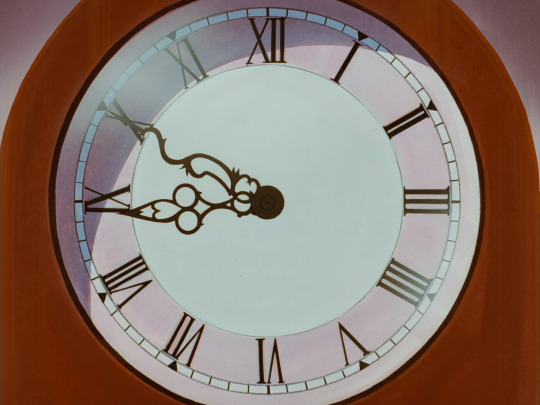
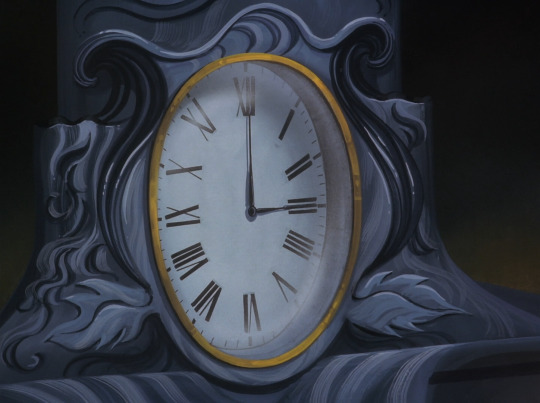

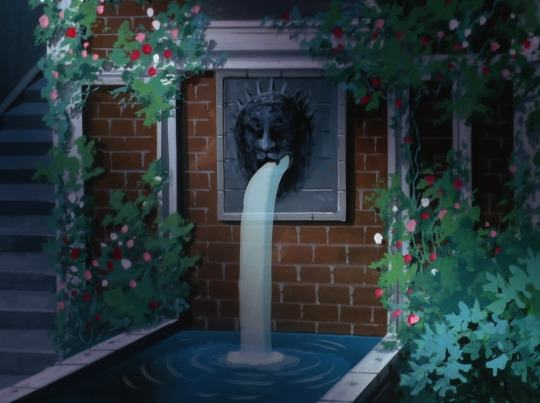
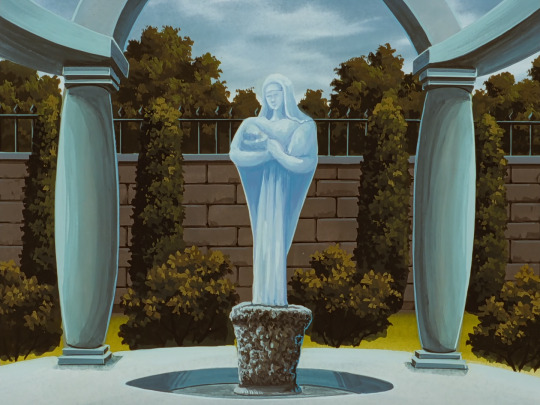

and Evil Dracula (1974) Dir : Michio Yamamoto
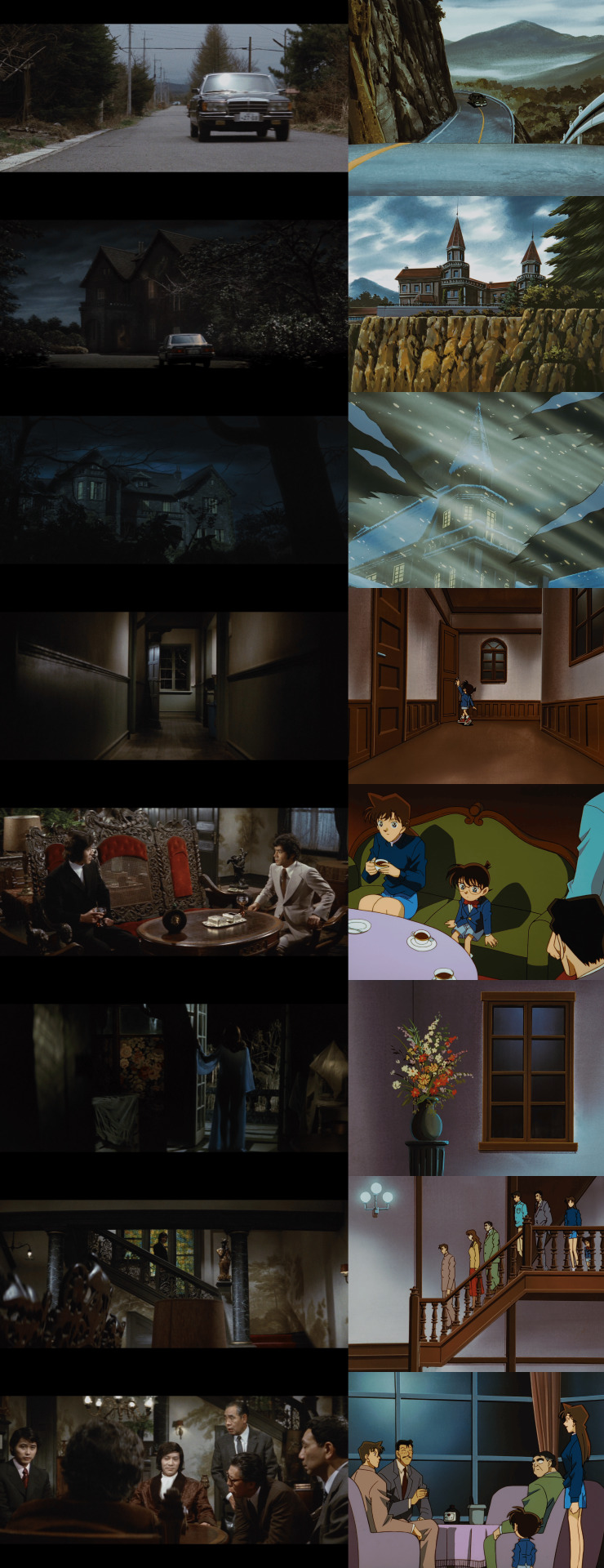
His creativity when it comes to adapting chapters has always been evident, using everything at his disposal, both in the framing and the photography : #176 opening scene.

Not to mention perhaps his most well-known episode, which he wrote, storyboarded, and directed : #184 A Cursed Mask Coldly Laughs. It takes everything from episodes 88 and 89 and elevates it : the atmosphere, the theme of the curse tied to the mask, the suspense, and an extremely unconventional way of solving the mystery, visually simple yet complex in practice, in a very Aoyama-esque manner. One could almost believe the episode was written by Aoyama himself, though that is not the case.

353 notes
·
View notes
Text
[Updated Version]
Ran Mouri by the different Animation Directors (001-284).
須藤昌朋 Masatomo Sudo is the Character Designer of the show.




























120 notes
·
View notes
Text
山本 泰一郎 Yasuichiro Yamamoto is without a doubt, the most important figure in the history of the Detective Conan anime. He first joined the anime production on Episode 34 and quickly became a central creative force. He served as Series Director from Episodes 119 to 332, playing a key role in shaping the show’s tone, structure, and identity during its foundational years. He left his mark on openings, endings, OVAs, directed special episodes, movies etc... After a long break, Yamamoto returned as Series Director starting from Episode 667 and he’s still in that role today. Over the years, the anime production has changed a lot, but through all of that, Yamamoto has remained the most steady and reliable figure in the series. Even as the workload increased and things became more fragmented, he managed, as a veteran, to keep the anime consistent and coherent.
Here’s an overview of his work.
Yamamoto’s direction is not driven by loud visuals or a fixed aesthetic. While he doesn’t treat direction as a personal showcase, his work is far from neutral. It is defined by a set of technical and structural preferences that shape the way scenes unfold. It’s a style that doesn’t draw attention to itself, but that leaves a mark through how strong everything feels. He stands out for his versatility. Whether it’s suspenseful, dramatic, or realistic, he knows how to shape the visual language accordingly. He lets the manga or the original anime script lead the way. He adjusts his style to serve the story. What sets him apart is his careful craftsmanship. He ensures that character drawings remain clean and consistent, prioritizing subtle character acting animation over loose or exaggerated animation most of the time. He often incorporates technically demanding sequences like background animation, character acting animation, he loves playing with layers. He always manages to keep scenes dynamic, even when the script doesn’t call for it. Dialogues rarely feels static, he finds ways to make it visually engaging. Compared to other directors known for dynamic or exaggerated animation, his work feels more controlled and deliberate. It's likely one of the reasons why, despite joining the production a bit later (compared to 佐藤真人 Masato Sato or 越智浩仁 Hirohito Ochi) he was eventually chosen as Series Director after こだま兼嗣 Kenji Kodama.
His framing palette is flexible, but his choices lean more toward technical than stylistic experimentation.

Close up shots (+ #178 if you want to see how he uses them : here)

Split-Screen composition

You get it

Rotation / 'Zoom-In'




During key moments, he often uses highly stylized background art : irregular textures, brush strokes, ink washes, even erosion patterns.

Yamamoto first worked on the notable Episode 34 of Detective Conan (Mountain Villa Bandaged Man Murder Case Pt 1 - Storyboard / Episode Director : Yasuichiro Yamamoto), an important episode alongside Masato Sato, who handled Episode 35. Even then, his ambition stood out, not as a drastic shift in style, but as a clear intent to push the visual direction further. However, it’s in Episode 40 that his full capability as a director truly comes through.
Episode 40 (Wealthy Daughter Murder Case Pt 2 - Script / Storyboard / Episode Director : Yasuichiro Yamamoto) shows a tightly controlled use of a specific and precise color palette, shifting gradually from black to purple, then deep red and burnt orange, a palette that closes in on the viewer, building a quiet tension and a sense of confinement. The scene uses candlelight as the only light source, and the lighting is handled with impressive accuracy. The glow spreads softly, fading into darkness, and the tiles shift toward orange while the rest stay in shadow. You can spot small linear reflections on the wall, placed in the opposite direction of the candle. The water reflects the light, and even the mirror on the right catches a bit of it. Behind the characters, total darkness takes over because there’s no electricity. Every glow, reflection, and shadow is carefully anticipated and placed with intent. It adds a sense of realism and shows how much planning and effort went into the backgrounds. Yamamoto often works with scenes that feel static in the manga. Gosho’s chapters rely heavily on dialogue and minimal movement, but on screen, Yamamoto finds ways to bring them to life. He reimagines spaces, adds depth and atmosphere. The bathroom scene lit only by candlelight is a perfect example : what was a simple conversation on the page becomes something rich and immersive in the anime.


A comparison with the manga :

Episode 68 (Night Baron Murder Case Pt 1 - Storyboard : Masato Sato / Episode Director : Yasuichiro Yamamoto) which I consider one of the best directed episodes in the entire series, is a collaboration between two major names : Masato Sato and Yamamoto himself. And it doesn’t take long to see why it stands out. While the storyboard is by Sato, the episode clearly shows how much direction can influence the final result. From start to finish, it’s dynamic, ambitious, and fully committed to its tone. Every scene feels thoughtfully shaped, and the entire episode holds together with an impressive level of quality and consistency.




Episode 74 (The Death God Jinnai Murder Case - Storyboard / Episode Director : Yasuichiro Yamamoto) is an anime original episode, and it opens with a scene inside a movie theater, where the characters are watching a movie on screen. The way this 'movie' on screen is handled reveals everything about the director’s approach : it’s far from minimal, and instead treated with full of cinematic weight : rich lighting, sharp shadows, polished art direction, framing, focus, detailled drawings, and even original character designs just for this small scene. Everything is polished to the level of a standalone cliché like horror movie. Technically, this level of care wasn’t needed, the scene could’ve been played straight and nobody would’ve questioned it. This is what sets the director apart. He doesn't just deliver what's required, he goes further. Eveything is given full treatment and it’s a clear example of his ambition and versatility, always pushing to elevate, no matter how small it may seem.

Like the two other directors who each worked closely with a specific Animation Director (Sato with 河村明夫 Akio Kawamura and Ochi with 大河原晴男 Haruo Ogawara), Yamamoto mainly worked with 佐々木恵子 Keiko Sasaki. Sasaki’s corrections are highly meticulous and consistent, closely aligned with the official character design sheets by 須藤昌朋 Masatomo Sudo. Her work doesn't aim to stand out stylistically, and that’s what defines it. It’s restrained, balanced, and technically faithful. In a way, her drawings feels 'neutral', not in a negative sense, but in how structurally correct it is. Over time and under the director’s guidance, Sasaki’s drawings gradually took on a more realistic tone. Without losing their adherence to the model sheets, they became more refined, less stylized, and more sync with the director’s serious and calculated tone. This partnership contributed to giving certain episodes a sharper visual identity, one that felt closer to realism, both in the drawings and the mood.
#40 > #52 > #68 > #91 > #128 (Animation Director : Keiko Sasaki under Yasuichiro Yamamoto)

There’s often a clear duality within the episodes he storyboard/directs, especially in how he uses color and tone to shape the atmosphere of each scenes. Each sections gets its own distinct mood, whether it’s bright and energetic or tense and heavy :
#82 (The Kidnapping of a Popular Artist Case Pt2 - Storyboard / Episode Director : Yasuichiro Yamamoto)
#128 (The Black Organization: One Billion Yen Robbery Case - Storyboard : Yasuichiro Yamamoto / Episode Director : Minoru Tozawa)

Episode 489 (Courtroom Confrontation III: Prosecutor as Eyewitness - Storyboard / Episode Director : Yasuichiro Yamamoto) stands out as, arguably, the director’s best work for me, and interestingly, it comes after the traditional animation era and under Masato Sato as the Series Director. While much of his reputation is built on his work from that earlier period, this episode proves that his strengths carried over into the digital age with just as much force. Here, the direction takes a turn toward something colder, more grounded, reminiscent of Japanese live-action police procedurals or courtroom dramas. The color palette is subdued, desaturated, and leans into steely greys, muted blues, washed-out greens, far from the warmer, saturated tones often used in Detective Conan. The episode is aiming to be taken more seriously than usual. The framing, photography and color palette support this tone completely. Wide shots of modern buildings, institutional interiors, and overcast skies give the episode a sense of distance, isolation, and heavy realism. There’s a kind of emotional stillness in the way scenes are framed, everything feels quiet, held back, deliberate, things we never hear about, that often take place in the middle of the night. It’s a very different tone from the usual, a bit more theatrical, more adult, and that’s exactly what makes it special. It may be a personal preference, but for me, this is his most refined and complete episode. A key factor in this episode is the presence of 宍戸久美子 Kumiko Shishido as Chef Animation Director. Her clean, grounded drawing style brings even more weight and realism to the characters. Paired with the director’s precise and minimalist tone, her corrections elevates the episode’s atmosphere in a way that feels completely different from the rest of the series.
Art Direction : 中久木孝将 Takamasa Nakakuki


A comparison between Episode 264 (Courtroom Confrontation: Kisaki vs. Kogoro) and Episode 489 (Courtroom Confrontation III: Prosecutor as Eyewitness) : Traditional Era vs Digital Era. Art Direction, Textures, Photography, Color Palette, Drawings etc...

Influences drawn from shows like Aibo (2000)

Animation Director : Kumiko Shishido

As Detective Conan anime production became increasingly complex over the years, with tighter schedules and a much heavier workload, Yamamoto managed to adapt the Kyoto Arc with remarkable control. Despite many limitations, he brought a clear vision and kept the pacing dynamic, using smart animation techniques to compensate where needed. It’s another reminder that in animation, pure creativity alone isn’t enough, you need the full package to pull something like this off. Episodes 926 and 927 combined make up 90 minutes, essentially the length of a Conan movie. I explain it in more detail in this thread : here.
Episode 927 (The Scarlet School Trip Pt 2 - Script / Storyboard / Episode Director : Yasuichiro Yamamoto) Close-up shots to build a sense of intimacy and physical presence, focusing on hands, movement, and subtle gestures. Something that wasn’t fully developed in the chapters due to pacing constraints. It feels like the director is filling in what Gosho didn’t have time to expand.

Yamamoto’s signature


Yamamoto's Storyboard sketches

He worked on almost everything : the Conan TV series, the movies, openings and endings (including the iconic Ending 10), OVAs (like the first Conan × Kaito × Yaiba special, which is an impressive piece of work - Storyboard / Episode Direction : Yasuichiro Yamamoto), Special Episodes (Episode One: The Great Detective Turned Small - Script / Storyboard / Episode Direction : Yasuichiro Yamamoto) and even magazine covers. For example, the recent AnAn issue featuring Kaito and Shinichi while the final illustration was by Iwao Teraoka and Sudo, the original layout was done by Yamamoto.


451 notes
·
View notes
Text
The official Sonic social media accounts recently posted Sonic doing a very familiar dance...
848 notes
·
View notes
Text
Signal boosting because censorship is absurd.
Censorship doesn't protect kids, parents need to be more aware of what media their kids consume. If your kid asks to watch or read certain media, give the media in question a look for yourself first.
Check the ratings on the back cover of the games or books they want to play, check the content warnings on the shows they want to watch on streaming services, they're not there for laughs and giggles.
Don't let them control this, because then they'll come after the media you love next for even stupider reasons.


74K notes
·
View notes
Text



Deltarune heroes in acrylic markers
2K notes
·
View notes
Text
Respect to Madame Zeroni
“But if you forget to reblog Madame Zeroni, you and your family will be cursed for always and eternity.”
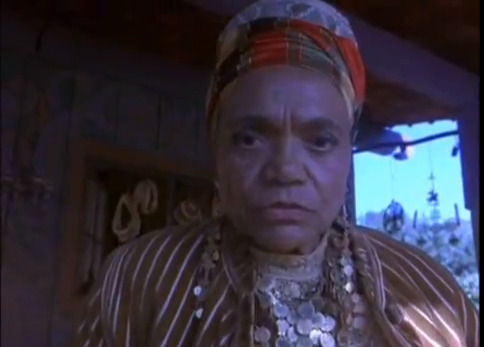
4M notes
·
View notes
Text

Klonoa Phantasy Reverie Series - Door to Phantomile "PS1 CG render" style
I merged the Klonoa "1997 CG render" style mod with this new one that includes all characters and other changes based on the "Cel-shaded" mod.


This is a mod that gives all characters and enemy entities a look based upon their PS1 counterparts. This is essentially the "cel-shaded" mod with the cel-shading off, but there still a couple differences from it.



Relevant UI/on-screen elements were also updated. (These are currently unchanged from the one's used in the "cel-shaded" mod, but I may update them later.) Also included are a few texture realignments such as the book seen at the end of the game's credits and some of the villager sprites on the world map.
Redrawn dialogue box and boss life gauge graphics are also included.

70 notes
·
View notes
Text
that was one of the biggest earthquakes ever recorded. that just hit. it got upgraded to an 8.8. there are so many tsunami warnings
if you are in an evacuation zone please stay safe
6K notes
·
View notes
Text





Guillermo Del Toro on AI "art"
SDCC 2025: Lucas Museum Of Narrative Art
33K notes
·
View notes
Text
Shinichi Kudo by different Animation Directors :


















Bonus :




#名探偵コナン#dcmk#detective conan#case closed#shinichi kudo#kudo shinichi#retro anime#animation direction#jimmy kudo
430 notes
·
View notes
Text
山本 泰一郎 Yasuichiro Yamamoto is without a doubt, the most important figure in the history of the Detective Conan anime. He first joined the anime production on Episode 34 and quickly became a central creative force. He served as Series Director from Episodes 119 to 332, playing a key role in shaping the show’s tone, structure, and identity during its foundational years. He left his mark on openings, endings, OVAs, directed special episodes, movies etc... After a long break, Yamamoto returned as Series Director starting from Episode 667 and he’s still in that role today. Over the years, the anime production has changed a lot, but through all of that, Yamamoto has remained the most steady and reliable figure in the series. Even as the workload increased and things became more fragmented, he managed, as a veteran, to keep the anime consistent and coherent.
Here’s an overview of his work.
Yamamoto’s direction is not driven by loud visuals or a fixed aesthetic. While he doesn’t treat direction as a personal showcase, his work is far from neutral. It is defined by a set of technical and structural preferences that shape the way scenes unfold. It’s a style that doesn’t draw attention to itself, but that leaves a mark through how strong everything feels. He stands out for his versatility. Whether it’s suspenseful, dramatic, or realistic, he knows how to shape the visual language accordingly. He lets the manga or the original anime script lead the way. He adjusts his style to serve the story. What sets him apart is his careful craftsmanship. He ensures that character drawings remain clean and consistent, prioritizing subtle character acting animation over loose or exaggerated animation most of the time. He often incorporates technically demanding sequences like background animation, character acting animation, he loves playing with layers. He always manages to keep scenes dynamic, even when the script doesn’t call for it. Dialogues rarely feels static, he finds ways to make it visually engaging. Compared to other directors known for dynamic or exaggerated animation, his work feels more controlled and deliberate. It's likely one of the reasons why, despite joining the production a bit later (compared to 佐藤真人 Masato Sato or 越智浩仁 Hirohito Ochi) he was eventually chosen as Series Director after こだま兼嗣 Kenji Kodama.
His framing palette is flexible, but his choices lean more toward technical than stylistic experimentation.

Close up shots (+ #178 if you want to see how he uses them : here)

Split-Screen composition

You get it

Rotation / 'Zoom-In'




During key moments, he often uses highly stylized background art : irregular textures, brush strokes, ink washes, even erosion patterns.

Yamamoto first worked on the notable Episode 34 of Detective Conan (Mountain Villa Bandaged Man Murder Case Pt 1 - Storyboard / Episode Director : Yasuichiro Yamamoto), an important episode alongside Masato Sato, who handled Episode 35. Even then, his ambition stood out, not as a drastic shift in style, but as a clear intent to push the visual direction further. However, it’s in Episode 40 that his full capability as a director truly comes through.
Episode 40 (Wealthy Daughter Murder Case Pt 2 - Script / Storyboard / Episode Director : Yasuichiro Yamamoto) shows a tightly controlled use of a specific and precise color palette, shifting gradually from black to purple, then deep red and burnt orange, a palette that closes in on the viewer, building a quiet tension and a sense of confinement. The scene uses candlelight as the only light source, and the lighting is handled with impressive accuracy. The glow spreads softly, fading into darkness, and the tiles shift toward orange while the rest stay in shadow. You can spot small linear reflections on the wall, placed in the opposite direction of the candle. The water reflects the light, and even the mirror on the right catches a bit of it. Behind the characters, total darkness takes over because there’s no electricity. Every glow, reflection, and shadow is carefully anticipated and placed with intent. It adds a sense of realism and shows how much planning and effort went into the backgrounds. Yamamoto often works with scenes that feel static in the manga. Gosho’s chapters rely heavily on dialogue and minimal movement, but on screen, Yamamoto finds ways to bring them to life. He reimagines spaces, adds depth and atmosphere. The bathroom scene lit only by candlelight is a perfect example : what was a simple conversation on the page becomes something rich and immersive in the anime.


A comparison with the manga :

Episode 68 (Night Baron Murder Case Pt 1 - Storyboard : Masato Sato / Episode Director : Yasuichiro Yamamoto) which I consider one of the best directed episodes in the entire series, is a collaboration between two major names : Masato Sato and Yamamoto himself. And it doesn’t take long to see why it stands out. While the storyboard is by Sato, the episode clearly shows how much direction can influence the final result. From start to finish, it’s dynamic, ambitious, and fully committed to its tone. Every scene feels thoughtfully shaped, and the entire episode holds together with an impressive level of quality and consistency.




Episode 74 (The Death God Jinnai Murder Case - Storyboard / Episode Director : Yasuichiro Yamamoto) is an anime original episode, and it opens with a scene inside a movie theater, where the characters are watching a movie on screen. The way this 'movie' on screen is handled reveals everything about the director’s approach : it’s far from minimal, and instead treated with full of cinematic weight : rich lighting, sharp shadows, polished art direction, framing, focus, detailled drawings, and even original character designs just for this small scene. Everything is polished to the level of a standalone cliché like horror movie. Technically, this level of care wasn’t needed, the scene could’ve been played straight and nobody would’ve questioned it. This is what sets the director apart. He doesn't just deliver what's required, he goes further. Eveything is given full treatment and it’s a clear example of his ambition and versatility, always pushing to elevate, no matter how small it may seem.

Like the two other directors who each worked closely with a specific Animation Director (Sato with 河村明夫 Akio Kawamura and Ochi with 大河原晴男 Haruo Ogawara), Yamamoto mainly worked with 佐々木恵子 Keiko Sasaki. Sasaki’s corrections are highly meticulous and consistent, closely aligned with the official character design sheets by 須藤昌朋 Masatomo Sudo. Her work doesn't aim to stand out stylistically, and that’s what defines it. It’s restrained, balanced, and technically faithful. In a way, her drawings feels 'neutral', not in a negative sense, but in how structurally correct it is. Over time and under the director’s guidance, Sasaki’s drawings gradually took on a more realistic tone. Without losing their adherence to the model sheets, they became more refined, less stylized, and more sync with the director’s serious and calculated tone. This partnership contributed to giving certain episodes a sharper visual identity, one that felt closer to realism, both in the drawings and the mood.
#40 > #52 > #68 > #91 > #128 (Animation Director : Keiko Sasaki under Yasuichiro Yamamoto)

There’s often a clear duality within the episodes he storyboard/directs, especially in how he uses color and tone to shape the atmosphere of each scenes. Each sections gets its own distinct mood, whether it’s bright and energetic or tense and heavy :
#82 (The Kidnapping of a Popular Artist Case Pt2 - Storyboard / Episode Director : Yasuichiro Yamamoto)
#128 (The Black Organization: One Billion Yen Robbery Case - Storyboard : Yasuichiro Yamamoto / Episode Director : Minoru Tozawa)

Episode 489 (Courtroom Confrontation III: Prosecutor as Eyewitness - Storyboard / Episode Director : Yasuichiro Yamamoto) stands out as, arguably, the director’s best work for me, and interestingly, it comes after the traditional animation era and under Masato Sato as the Series Director. While much of his reputation is built on his work from that earlier period, this episode proves that his strengths carried over into the digital age with just as much force. Here, the direction takes a turn toward something colder, more grounded, reminiscent of Japanese live-action police procedurals or courtroom dramas. The color palette is subdued, desaturated, and leans into steely greys, muted blues, washed-out greens, far from the warmer, saturated tones often used in Detective Conan. The episode is aiming to be taken more seriously than usual. The framing, photography and color palette support this tone completely. Wide shots of modern buildings, institutional interiors, and overcast skies give the episode a sense of distance, isolation, and heavy realism. There’s a kind of emotional stillness in the way scenes are framed, everything feels quiet, held back, deliberate, things we never hear about, that often take place in the middle of the night. It’s a very different tone from the usual, a bit more theatrical, more adult, and that’s exactly what makes it special. It may be a personal preference, but for me, this is his most refined and complete episode. A key factor in this episode is the presence of 宍戸久美子 Kumiko Shishido as Chef Animation Director. Her clean, grounded drawing style brings even more weight and realism to the characters. Paired with the director’s precise and minimalist tone, her corrections elevates the episode’s atmosphere in a way that feels completely different from the rest of the series.
Art Direction : 中久木孝将 Takamasa Nakakuki


A comparison between Episode 264 (Courtroom Confrontation: Kisaki vs. Kogoro) and Episode 489 (Courtroom Confrontation III: Prosecutor as Eyewitness) : Traditional Era vs Digital Era. Art Direction, Textures, Photography, Color Palette, Drawings etc...

Influences drawn from shows like Aibo (2000)

Animation Director : Kumiko Shishido

As Detective Conan anime production became increasingly complex over the years, with tighter schedules and a much heavier workload, Yamamoto managed to adapt the Kyoto Arc with remarkable control. Despite many limitations, he brought a clear vision and kept the pacing dynamic, using smart animation techniques to compensate where needed. It’s another reminder that in animation, pure creativity alone isn’t enough, you need the full package to pull something like this off. Episodes 926 and 927 combined make up 90 minutes, essentially the length of a Conan movie. I explain it in more detail in this thread : here.
Episode 927 (The Scarlet School Trip Pt 2 - Script / Storyboard / Episode Director : Yasuichiro Yamamoto) Close-up shots to build a sense of intimacy and physical presence, focusing on hands, movement, and subtle gestures. Something that wasn’t fully developed in the chapters due to pacing constraints. It feels like the director is filling in what Gosho didn’t have time to expand.

Yamamoto’s signature


Yamamoto's Storyboard sketches

He worked on almost everything : the Conan TV series, the movies, openings and endings (including the iconic Ending 10), OVAs (like the first Conan × Kaito × Yaiba special, which is an impressive piece of work - Storyboard / Episode Direction : Yasuichiro Yamamoto), Special Episodes (Episode One: The Great Detective Turned Small - Script / Storyboard / Episode Direction : Yasuichiro Yamamoto) and even magazine covers. For example, the recent AnAn issue featuring Kaito and Shinichi while the final illustration was by Iwao Teraoka and Sudo, the original layout was done by Yamamoto.


451 notes
·
View notes




